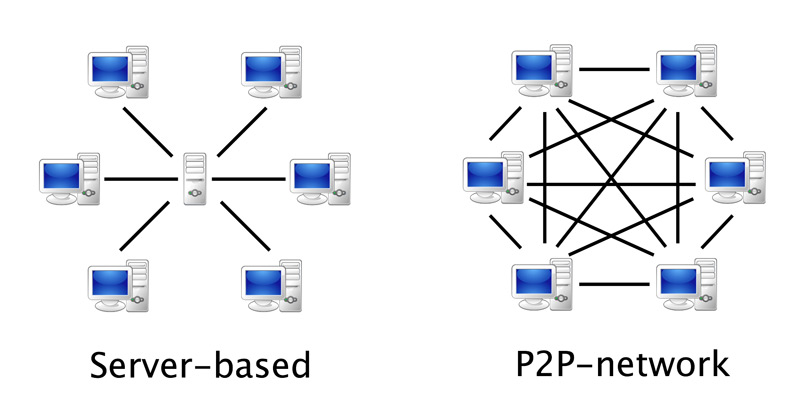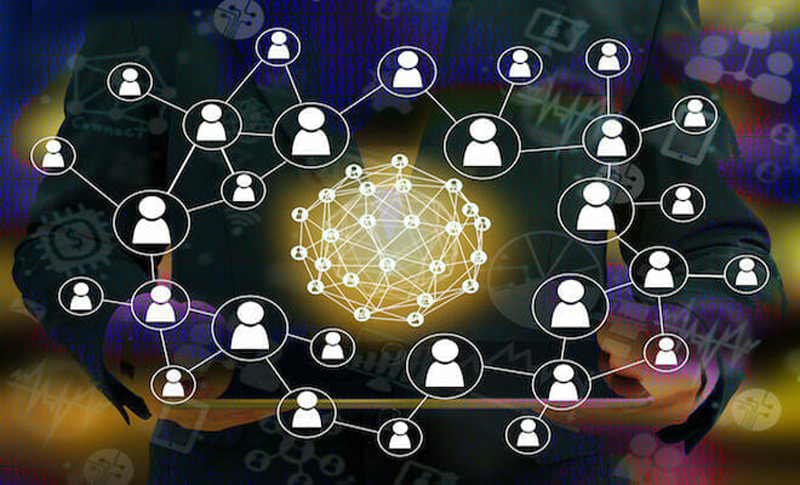
Index:
UPDATED ✅ Do you want to know what client-client or server pair downloads consist of and what software is there? ⭐ ENTER HERE
maybe mentioning you the P2P concept you stay the same It is something common for anyone who makes use of this system at the user level but who does not have knowledge at the level of advanced computing and the operation of the transfer of information through the network.
And this is precisely what it is about. P2P or Peer to Peersince it is a network with a communication method in which all users play the same role, that is, horizontally.
Find out what it is and how you can take advantage of this type of network to download software and applications in a much faster and safer way. Let’s go there!
What is a Peer to Peer network and what is it for? Definition

Peer to Peer or P2P network is a client-client communication method that allows us to enjoy information from the network coming from a peer, who acts, like us, both as a client and as a server. This means that it does not provide us with a superior, but rather someone who has characteristics similar to ours.
The information transmission aspect works no fixed clients or serversit is we ourselves, one and the other, who supply content to other users and at the same time receive it.
Other aspects can be defined in client-server relationshipsbut this one, which is what gives meaning to the network, is it horizontal or parallelgiven, as its name indicates when translated into Spanish, between pairs, between nodes that work in the same way.
The first application of the type was Napster, launched in 1999being sold as a software in which users establish a virtual network independent of the physical one, so that there is no administrative authority or other restriction.
Though In general, this concept is designated to content download programsthe truth is that, due to its characteristics, the exchange that can take place is not limited to this aspect but we have to the peer network It is also used by telephony systems in the network as well as the manipulation of huge virtual information.
How does a P2P peer network work?
The contents of our computer (music, documents, videos, software…) are available to be shared and that another user, just like us, download and run them at will.
In the same way, when we search and find a contentthis does not belong to a company nor is it on a server, but the results that are reflected correspond to the content that other users have on their computers, proceeding to download them, if we wish, from them.
Any computer interconnected on the same network offers and receives information in all formats at the same time. The implementation of the networks is of superposition, being built based on nodes and on others. The flow of information occurs thanks to the bandwidth of the connected users.
What are the characteristics of Peer to Peer networks? Advantages and disadvantages

To consider a peer network as adequate, it is interesting that it has the following characteristics.
Characteristic
- Scalability: Its reach is worldwide and, therefore, the potential user can number in the hundreds of millions. The greater the demand, the greater the need for nodes or points, something that is automatically solved because with our presence as a user we provide a unit for it. The addition of a new user does not imply a delay in the functionality of the services, as it does in server-client communications.
- Sturdiness: The distribution of the networks makes it more robust, essential when failures occur due to data replication.
- Decentralization: They are decentralized by definition, an intrinsic feature of the concept. The nodes do not have special functions and therefore are not essential. Interestingly, some of the networks that we know as P2P do not have this feature.
- Cost distribution: Resources are exchanged for resources, the costs being divided among all the users that are part of the network.
- Anonymity: Anonymity is desired not only for those who have a file to share but also for those who want to download it, for the server where it is located and even for the request made to access it. However, this concept collides squarely with copyright, digital rights management coming into play, an intermediate point for which everyone is satisfied but, unfortunately, it does not usually work.
- Security: Desirable but difficult to achieve, really. What is most in demand is the identification of malicious nodes to avoid content with embedded malware, espionage and other aspects that put all users at risk. To do this, some networks have sandboxes, multikey encryption, file comments, reputation systems for users…
Advantage
- Reduced costs: The ability to function by sharing resources means that these networks can even be free. Another matter would be that a free service is compatible with the legality when it comes to sharing files. In any case, those that work by subscription are very cheap, much more than purchasing the content separately.
- High Efficiency: The way to share the files is simple and fast.
Disadvantages
- Legality: Sometimes, many times, content is shared that is copyrighted, which turns out to be, in effect, illegal. The law penalizes this practice in many countries, among which is Spain.
- Risk: Many of these Peer to Peer file transfer programs are a gateway to malware, especially spyware. Thus, it is necessary that you have protection and, if possible, look for a service with preview, user comments and other methods of detecting inappropriate and risky content.
What types of P2P peer-to-peer networks are there?
The most common and interesting classification that we can make is related to the degree of centralization of networkshaving that these may be centralized, mixed or pure.
centralized
- Its architecture is monolithicwith transactions carried out through a single server that serves to link all the nodes at the same time that it makes a distribution of the nodes that will store the contents.
- His administration is very dynamic.the content being permanently available.
- Privacy of users is limited.
- There is a strong lack of scalability.
- There are problems of single point of failurerelated to legality and maintenance costs and band consumption.
Mixed
- There is a central server that acts as hub centralizing resources and managing them that is waiting for requests.
- There is a system of indexes that offers an absolute address that will act as routing terminal.
- In addition, it is allowed inclusion of more than one server.
- The identity of the nodes is not known nor is their information stored, not giving the share between server and clients.
- These are the ones they save the informationwhich will be recognized by the server.
- Even so, with the server down, the relationship between the nodes can be maintained and your communication and file transfer.
pure
- It does not count with core management I don’t even need it.
- They are the users, the nodes, all of them clients and servers, asking for information, receiving the requests and, in turn, storing the files.
- Lacks central router.
Legal problems with copyright and copyright and the use of P2P services

If you have ever seen how the popular programs we have seen above work, you will have verified that there is an abundance of content that, clearly, should not be distributed because it has rights. In other words, a constant crime is incurred both by the party that distributes it without permission and by the party that downloads it knowing its nature.
However, these are also given a legal use, which includes the exchange of public content or with various licenses that allow this information transfer, free programs, self-created content…
A) Yes, the UN talks about the exchange of files indicating that it is very serious that citizens are denied access to the network (whatever the motivation), a totalitarian measure but that is taking place in some countries precisely because of the infringement of the regulations regarding copyright.
Regarding the situation in our country, there is a certain cloud that makes downloading content is considered legal or illegal depending on, of course, who represents you and who judges you for it.
It turns out that there is a right to private copying of content if it is not done for profit, how is it supposed to be done when downloading files on peer networks, assuming own and private consumption. This allows that a request is not necessary for the author to authorize the copy of the content.
In Spain it is allowed to use these networks, because, as we have indicated, with them the access to free content to be distributed is facilitated. It is up to each individual to make responsible or illegal use of these, downloading and helping to distribute free or copyrighted content.
In 2008 the Spanish government indicated that the link to these networks is not a criminal activity. Yes we have a reform of the Criminal Code in 2015 that tells us about a new crime committed by someone who seeks an economic benefit, harming a third party, facilitating, without neutrality, access or easy location of content that has intellectual property if its owners do not authorize it.
networks